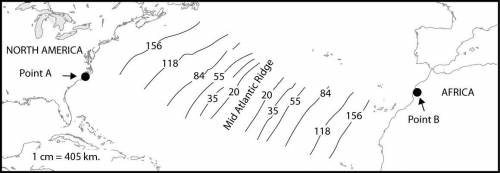
Each year, new seafloor is added at the Mid-Atlantic Ridge. The Atlantic Ocean widens, causing North and South America to move farther away from Europe and Africa. Close to the ridge, rocks are younger. As you move away from the ridge, the rocks become older.
The rate of seafloor spreading has not been the same over time. In this activity, you will calculate the average rate of seafloor spreading and then determine when the seafloor started to spread.
1. Where would you find the oldest sections of seafloor, near the continents or near the Mid-Atlantic Ridge?
Working with Map Scales
Below is a map of a section of the North Atlantic. You can see the coastlines of North America and Africa. On both sides of the Mid-Atlantic Ridge, strips of seafloor are labeled with their ages in millions of years. Note the map scale.
2. What is the scale of the map? For this activity, you will use centimeters.
cm = km
3. Choose one strip of seafloor rock. What is the age of the rock?
4. Use your ruler to measure the distance of the strip from the Mid-Atlantic Ridge.
cm
5. Using the calculator, multiply the answer to #4 by 405 to figure out its distance in kilometers. Round to the nearest whole number.
km
Determining Rate of Spreading
Use the age of the rock you have chosen and its distance from the Mid-Atlantic Ridge to calculate seafloor spreading.
6. First you will find out how fast the seafloor is moving away from the ridge on one side. Use a calculator to divide the answer to #5 by the answer to #3. Round to the nearest whole number.
#5 km ÷ #3 million years = km/million years
7. Now find out how fast the seafloor widens every 1 million years. Multiply the answer you got in #6 by 2.
The seafloor spreads at a rate of km every 1 million years.
When Did the Seafloor Start Spreading?
The distance between Point A and Point B, or the coasts of Africa and North America, is 4,550 km. Using your answer to #7, find out when the Atlantic Ocean began to open. Divide 4,550 km by your answer in #7 to find out.
8. 4,550 km ÷ #7 = million years ago.
9. Look at the Geologic Timeline. During what geologic period did the Atlantic start to open?
See if you can figure out the rate of floor spreading (in cm/year) between North America and Africa.
10. #7 x 1000 m x 100 cm ÷ 1,000,000 years = cm/year
11. How far, in centimeters, has the distance between North America and Africa increased since you were born? Multiply the rate by your age.
cm
12. How much has the distance increased during the average lifetime of 82 years?
cm
13. How much closer were the continents when Columbus crossed the Atlantic in 1492?
cm


Answers: 2


Other questions on the subject: Geography

Geography, 22.06.2019 09:30, bbyitskeke7160
What makes a personal exceptionality/non-exceptionality
Answers: 2

Geography, 23.06.2019 00:00, Jxsolvez
Yo! a girl out ! i will give brainliest! hu one of the main reasons societies settled along rivers in the neolithic era was because a) the village elders demanded it. b) the land there was more valuable. c) it was more safe and secure there. d) it provided irrigation for farming.
Answers: 2

Geography, 23.06.2019 17:00, carlosiscr7
Select the natural regions. delta denver forest georgia north america plateau stream
Answers: 1

Geography, 23.06.2019 17:00, jessie9772
In russia which of these challenges affects the transportation of both petroleum products and other goods?
Answers: 1
You know the right answer?
Each year, new seafloor is added at the Mid-Atlantic Ridge. The Atlantic Ocean widens, causing North...
Questions in other subjects:

Mathematics, 05.05.2020 04:44


Biology, 05.05.2020 04:44



Mathematics, 05.05.2020 04:44

Mathematics, 05.05.2020 04:44

History, 05.05.2020 04:44


Mathematics, 05.05.2020 04:44



